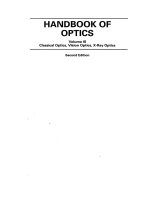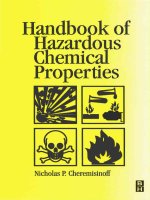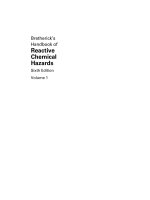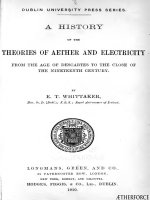handbook of reactive chemical hazards vol 1 (bretherick 1999)
Bạn đang xem bản rút gọn của tài liệu. Xem và tải ngay bản đầy đủ của tài liệu tại đây (6.28 MB, 2,129 trang )
Bretherick’s
Handbook of
Reactive
Chemical
Hazards
Sixth Edition
Volume 1
AN INDEXED GUIDE TO PUBLISHED DATA
Bretherick’s
Handbook of
Reactive
Chemical
Hazards
Sixth Edition — Volume 1
Edited by
PGUrben
Akzo-Nobel
Compiler
MJPitt
Department of Chemical Engineering
University of Leeds
Butterworth-Heinemann Ltd
Linacre House, Jordan Hill, Oxford OX2 8DP
First published 1975
Second edition 1979
Reprinted 1979, 1981, 1984
Third edition 1985
Reprinted 1987, 1989
Fourth edition 1990
Fifth edition 1995
Sixth edition 1999
© Butterworth-Heinemann 1999
All rights reserved. No part of this publication may be reproduced in any material
form (including photocopying or storing in any medium by electronic means and
whether or not transiently or incidentally to some other use of this publication)
without the written permission of the copyright holder except in accordance with the
provisions of the Copyright, Designs and Patents Act 1988 or under the terms of a
licence issued by the Copyright Licensing Agency Ltd, 90 Tottenham Court Road,
London, England W1P 9HE. Applications for the copyright owners written
permission to reproduce any part of this publication should be addressed to the
Publishers.
British Library Cataloguing in Publication Data
A record for this title is available from the British Library
Library of Congress Cataloguing in Publication Data
A record for this title is available from the Library of Congress
ISBN 0 7506 3605 X
Typeset by Laser Words, Madras, India
Printed and bound in Great Britain by Bath Press
Foreword
It is now commonplace to say that the growth of knowledge of every sort is
exponential and that keeping abreast with it becomes more difficult every year. As
a result research can often become re-search, discovering again what is already
described somewhere in the literature, perhaps in a little-known journal or little-
read book.
In many fields the worst result is a waste of resources on repetitive work but
when safety is concerned the lack of access to available knowledge can have
tragic results. Those of us who have been working in the safety field for many
years have seen the same accidents repeat themselves with distressing regularity.
We welcome, therefore, every attempt to bring together scattered information on
any aspect of safety and make it readily accessible.
In preparing the first four editions of this book Leslie Bretherick, almost unaided,
produced a masterly summary of available information on reactive chemicals and
their reactions. It was a remarkable achievement for one man, especially when we
remember that the earlier editions were prepared in his spare time! Now that he
has retired a team of editors, led by Peter Urben, has carried on the good work.
They have increased the length of this edition by adding data on about 200 new
compounds in Part 1, making the total nearly 5000, and 30 new groups in Part 2,
making the total about 650. Leslie’s high standard has been maintained.
It is a tribute to Leslie that very little of the new information in the 5th and
this edition is old stuff that he missed; almost all comes from new publications.
The entries on new groups range from acrylates to yeast passing through drums,
fumes, mists and pnictides on the way. Familiar accidents continue to occur and
new entries have been added on well-known hazards, such as nitric acid and azides.
In reviewing an earlier edition, I compared Leslie with those immortals, Beilstein
and Perry, and said that he would become as well-known. Today I would go
further and say that he has done more. He, and his successors, have not just made
knowledge available but have saved lives and prevented injuries and damage and
will continue to do so for many years.
Knowledge is effective only if it is used. Many coffee table books and cookery
books are used to decorate the living room and kitchen rather than add to our
knowledge. Some engineers are known to buy books to impress their visitors or
v
perhaps with good intentions that are never fulfilled. As an author I don’t complain
but I hope your copy of this book does not undergo this fate. Look up the entries
on all the compounds and groups of compounds you use or are thinking of using
(now, not after your accident). Also, look up the entries on substances you used
in the past and think of what might have happened.
The editors have done their bit; the publishers have done their bit by making
the data available in book form and on CD-ROM. It is now up to you. As a bonus
you will find the data fascinating to browse through, you will come across many
facts that you never knew before, or had forgotten, and you will be amused by the
deadpan humour of a few entries such as those on air, environmentalism, safety
literature, sunspots and superiors.
TREVOR KLETZ
April 1999
vi
Preface to the Sixth Edition
Bretherick’s Handbook remains broadly similar to the previous editions but older
readers will notice some changes. There are, of course, some hundreds of addi-
tional entries and much supplementary information in existing entries. This is
the second edition for which I have been responsible and readers will still regret
the absence of Leslie Bretherick, who had to withdraw from compilation because
of worsening sight but remains a support and stay. The bulk is still his work,
which is an indication of his immense labours laying the foundations, when
accidents were less often reported and databases harder to compile than they
now are. The present editor and his assistants have a far easier task continuing
the work.
The change in the cyclic structures, now drawn in the more contemporary nota-
tion for which Hampden Data Services are to be thanked continues. The book
is also now available as an electronic database, with all the improved ease of
searching for cross-references or related materials which that brings. In future, it
is proposed to supplement this rather more frequently than the new editions of the
book will appear.
The present edition includes the literature until the end of 1998. There are few
organisational changes from Leslie Bretherick’s model, although no new references
to safety data sheets are given. There are ever proliferating series of these, it would
be impossible to read all and invidious to distinguish some, while others appear
to have been compiled by (mis)information (ne)scientists in the library rather than
by chemists skilled and experienced in lab and plant.
Once again, we request all users to inform us of any hazards of which they are
aware and of which we are not, as also of any errors they find (regretfully, I must
admit that some will certainly have escaped detection). Thanks are given to all
those who have contributed to this and previous editions.
I have been valiantly assisted in the compilation and evaluation of data by
Dr Martin Pitt of the University of Sheffield. I am also indebted to the staff of
Butterworth-Heinemann and Hampden Data Services for their ability to make my
files manifest as book and database.
My employers, Courtaulds plc, (recently subsumed into Akzo-Nobel) have gener-
ously allowed me time to undertake this work which, while both yet existed,
vii
benefited greatly from their library and from the Courtaulds Library at the Univer-
sity of Warwick. But, above all, thanks are due to Leslie Bretherick, not only for
assistance and counsel but because, without him, the whole would be inconceivable.
We again wish him a long and active (semi)retirement.
P. URBEN
March 1999
viii
Preface to the First Edition
Although I had been aware during most of my career as a preparative chemist of
a general lack of information relevant to the reactive hazards associated with the
use of chemicals, the realisation that this book needed to be compiled came soon
after my reading Chemistry & Industry for June 6th, 1964. This issue contained an
account of an unexpected laboratory explosion involving chromium trioxide and
acetic anhydride, a combination which I knew to be extremely hazardous from
close personal experience 16 years previously.
This hazard had received wide publicity in the same journal in 1948, but during
the intervening years had apparently lapsed into relative obscurity. It was then
clear that currently existing arrangements for communicating ‘well-known’ reac-
tive chemical hazards to practising chemists and students were largely inadequate.
I resolved to try to meet this obvious need for a single source of information
with a logically arranged compilation of available material. After a preliminary
assessment of the overall problems involved, work began in late 1964.
By late 1971, so much information had been uncovered but remained to be
processed that it was apparent that the compilation would never be finished on
the spare-time basis then being used. Fortunately I then gained the support of
my employers, the British Petroleum Company, Ltd., and have now been able to
complete this compilation as a supporting research objective since January 1972.
The detailed form of presentation adopted has evolved steadily since 1964 to
meet the dual needs for information on reactive chemical hazards in both specific
and general terms, and the conflicting practical requirements of completeness and
brevity. A comprehensive explanation of how this has been attempted, with sugges-
tions on using this Handbook to best advantage, is given in the Introduction.
In an attempt to widen the scope of this work, unpublished information has been
sought from many sources, both by published appeals and correspondence. In this
latter area, the contribution made by a friend, the late Mr A. Kruk-Schuster, of
Laboratory Chemicals Disposal Company, Ltd., Billericay, has been outstanding.
During 1965–1968 his literature work and global letter campaign to 2000 Univer-
sity chemistry departments and industrial institutions yielded some 300 contribu-
tions.
ix
The coverage attempted in this Handbook is wide, but is certainly incomplete
because of the difficulties in retrieving relevant information from original literature
when it does not appear in the indices of either primary or abstract journals. Details
of such new material known to users of this Handbook and within the scope given
in the Introduction will be welcomed for inclusion in supplementary or revised
editions of this work.
L.B
October 1974
x
Contents
Volume 1
INTRODUCTION
Aims of the Handbook xi
Scope and Source Coverage xi
General Arrangement xii
Specific Chemical Entries (Volume 1) xiii
Grouping of Reactants xiv
General Group Entries (Volume 2) xv
Nomenclature xv
Cross-reference System xvii
Information Content of Individual Entries xvii
REACTIVE CHEMICAL HAZARDS
Basics xix
Kinetic Factors xix
Adiabatic Systems xxii
Reactivity vs. Composition and Structure xxii
Reaction Mixtures xxiii
Protective Measures xxiv
SPECIFIC CHEMICALS
(Elements and compounds arranged in formula order)
xi
APPENDIX 1 Source Title Abbreviations used in Handbook
References 1927
APPENDIX 2 Tabulated Fire-related Data 1937
APPENDIX 3 Glossary of Abbreviations and Technical Terms 1947
APPENDIX 4 Index of Chemical Names and Serial Numbers used as
Titles in Volume 1 1951
APPENDIX 5 Index of CAS Registry Numbers and Text Serial
Numbers 2081
xii
Introduction
THIS SHOULD BE READ THROUGH CAREFULLY
TO GAIN FULL BENEFIT FROM WHAT FOLLOWS
Aims of the Handbook
This compilation has been prepared and revised to give access to a wide and
up-to-date selection of documented information to research students, practising
chemists, safety officers and others concerned with the safe handling and use of
reactive chemicals. This will allow ready assessment of the likely potential for
reaction hazards which may be associated with an existing or proposed chemical
compound or reaction system.
A secondary, longer-term purpose is to present the information in away which
will, as far as possible, bring out the causes of, and interrelationships between,
apparently disconnected facts and incidents. This is designed to encourage an
increased awareness of potential chemical reactivity hazards in school, college
and university teaching laboratories, and to help to dispel the relative ignorance
of such matters which is still in evidence in this important area of safety training
during the formative years of technical education.
Others involved in a more general way with the storage, handling, packing,
transport and distribution of chemicals, or emergencies related thereto, are likely
to find information of relevance to their activities.
Scope and source coverage
This Handbook includes all information which had become available to the editor
by January 1999 on the reactivity hazards of individual elements or compounds,
either alone or in combination. Appropriate source references are included to give
access to more expansive information than that compressed into the necessarily
abbreviated text entries.
A wide variety of possible sources of published information has been scanned
to ensure maximum coverage. Primary sources have largely been restricted to
journals known to favour or specialise in publication of safety matters, and the
textbook series specialising in synthetic and preparative procedures.
Secondary sources have been a fairly wide variety of both specialised and
general textbooks and encyclopaedic collections (notably those of Mellor, Sidg-
wick, Pascal and Bailar in the inorganic area, Houben-Weyl in the organic and
xiii
organometallic areas, and Kirk-Othmer in the industrial area). Section 50 of Chem-
ical Abstracts, the CAS selection Chemical Hazards, Health, & Safety, the Univer-
sities’ Safety Association Safety News, the CIA CISHC Chemical Safety Summary,
(publication of which ceased in 1986 after 56 years), and the IChE Loss Prevention
Bulletin have been rich sources, together with the more recent RSC Laboratory
HazardsBulletin and Chemical Hazards in Industry. Additionally, various safety
manuals, compilations, summaries, data sheets and case histories have been used,
and fuller details of all the sources used are set out in Appendix 1. References in
the text to textbooks are characterised by absence of the author’s initials after the
surname.
More recently, some reports have been picked from the Internet, when two of the
three following conditions obtained: the editor finds the report credible; it repre-
sents a hazard not already present in the handbook; or the source is authoritative.
Information on toxic hazards has been specifically excluded because it is available
elsewhere in many well-ordered and readily usable forms.
However, it should be remembered that many of the compounds included in this
Handbook show high reactivity of one sort or another toward other materials, so
may in general terms be expected to be reactive even in brief contact with animal
organisms or tissue (including yours), with possible toxic effects, either acute or
chronic. Also, no attempt has been made to include details of all flammable or
combustible materials capable of burning explosively when mixed with air and
ignited, nor of any incidents related to this most frequent cause of accidents, such
information again being available elsewhere.
However, to focus attention on the potential hazards always associated with the
use of flammable and especially highly flammable substances, some 560 gases and
liquids with flash points below 25
°
C and/or autoignition temperature below 225
°
C
have been included in the text, their names prefixed with a dagger. The numerical
values of the fire hazard-related properties of flashpoint, autoignition temperature
and explosive (flammability) limits in air where known are given in the tabular
Appendix 2. Those elements or compounds which ignite on exposure to air are
included in the text, but not in the Table.
General arrangement
The information presented on reactive hazards is of two main types, specific or
general, and these types of information have been arranged differently in their
respective separate volumes 1 and 2.
FOR CROSS REFERENCES IN CAPITALS, PAGE NUMBERS REFER TO VOLUME 2.
Specific information on instability of individual chemical compounds, and
on hazardous interactions of elements and/or compounds, is contained in the
main formula-based Volume 1 of the Handbook. For an example of an unstable
compound,
see Ethyl perchlorate
For an example of a hazardous interaction between 2 compounds,
see Nitric acid: Acetone
or 2 separate examples involving the same compound,
xiv
see Nitric acid: Acetone, or: Ethanol
and one involving 3 compounds,
see Hydrogen peroxide: Nitric acid, Thiourea
General information relating to classes or groups of elements or compounds
possessing similar structural or hazardous characteristics is contained in the smaller
alphabetically based Volume 2.
See
ACYL NITRATES
PYROPHORIC METALS
References in the text to these general classes or groups of materials is always
in small capitals to differentiate them from references to specific chemicals, the
names of which are given in normal roman typeface.
Some individual materials of variable composition (substances) and materials
which cannot conveniently be formulated and placed in Volume 1 are also included
in this general section.
See
BLEACHING POWDER, CELLULOSE NITRATE
Both theoretical and practical hazard topics, some indirectly related to the main
theme of this book, are also included.
See
DISPOSAL, EXPLOSIBILITY
GAS CYLINDERS, OXYGEN ENRICHMENT
Several topics which bring together incidents involving a common physical
cause or effect but different types of chemicals are now included in Volume 2.
See
CATALYTIC IMPURITY INCIDENTS
GAS EVOLUTION INCIDENTS
Specific chemical entries (Volume 1)
A single unstable compound of known composition is placed in the main first
volume and is located on the basis of its empirical molecular formula expressed
in the Hill system used by Chemical Abstracts (C and H if present, then all
other element symbols alphabetically). The use of this indexing basis permits a
compound to be located if its structure can be drawn, irrespective of whether a
valid name is known for it. A representation of the structure of each compound is
given on the third bold title line while the name of the compound appears as the
first bold title line. References to the information source are given, followed by a
statement of the observed hazard, with any relevant explanation. Cross-reference to
similar compounds, often in a group entry, completes the entry. See Trifluoroacetyl
nitrite p. 244.
Where two or more elements or compounds are involved in a reactive hazard,
and an intermediate or product of reaction is identifiable as being responsible
for the hazard, both reacting substances are normally cross-referred to the identi-
fied product. The well-known reaction of ammonia and iodine to give explosive
nitrogentriodide-ammonia is an example of this type. The two entries
Ammonia: Halogens
Iodine: Ammonia
are referred back to the main entry under the identified material
Nitrogen triodide-ammonia
xv
No attempt has been made, however, to list all combinations of reactants which
can lead to the formation of a particular main entry compound.
In a multi-reactant system where no identification of an unstable product was
possible, one of the reactants had to be selected as primary reactant to prepare
and index the main entry, with the other material(s) as secondary reactant(s). No
strictly logical basis of choice for this is obvious.
However, it emerged during the compilation phase that most two component
reaction hazard systems of this type involve a fairly obvious oxidant material as
one of the reactants. Where this situation was recognised, the oxidant has normally
been selected as primary (indexing) reactant, with the other as secondary reactant,
following the colon.
See Potassium permanganate: Acetic acid, etc.
In the markedly fewer cases where an obvious reducant has been involved as
one reactant, that was normally selected as primary reactant.
See Lithium tetrahydroaluminate: 3,5-Dibromocyclopentene
In the relatively few cases where neither (or none) of the reactants can be
recognised as an oxidant or reducant, the choice was made which appeared to give
the more informative main entry text.
See Chloroform: Acetone, etc.
Where some hazard has been noted during the preparation of a specific compound,
but without it being possible to identify a specific cause, an entry for that compound
states ‘Preparative hazard’, and back-refers to the reactants involved in the prepa-
ration.
See Sulfur dioxide
Occasionally, departures from these considerations have been made where such
action appeared advantageous in bringing out a relationship between formally unre-
lated compounds or hazards. In all multi-component cases, however, the secondary
reactants (except air and water) appear as formula entries back-referred to the main
entry text, so that the latter is accessible from either primary or secondary reactants.
See Dimethyl sulfoxide: Acyl halides (main entry)
Acetyl chloride: Dimethyl sulfoxide (back reference)
Grouping of Reactants
There are advantages to be gained in grouping together elements or compounds
showing similar structure or reactivity, because this tends to bring out the rela-
tionships between structure and activity more clearly than separate treatment. This
course has been adopted widely for primary reactants (see next heading), and
for secondary reactants where one primary reactant has been involved separately
with a large number of secondary materials. Where possible, the latter have been
collected together under a suitable general group title indicative of the composition
or characteristics of those materials.
See Chlorine: Hydrocarbons
Hydrogen peroxide: Metals, Metal oxides, Metal salts
Hydrogen sulfide: Oxidants
xvi
This arrangement means, however, that some practice will be necessary on the
user’s part in deciding into what group an individual secondary reactant falls before
the longer-term advantages of the groupings become apparent. The formal group
titles listed in Volume 2, Appendix 3, and classified in Appendix 4, will be of use
in this connection. However, it should be noted that sometimes informal group
titles are used which do not appear in these Appendices.
General group entries (Volume 2)
In some cases literature references relating to well-defined groups of hazardous
compounds or to hazard topics have been found, and these are given, with a
condensed version of relevant information at the beginning of the topic or group
entry, under a suitable bold title, the latter being arranged in alphabetical order in
Volume 2.
Cross references to related group or sub-group entries are also included, with a
group list of the names and serial (not page) numbers of the chemicals appearing
in Volume 1 which lie within the structural or functional scope of the group entry
title. Compounds which are closely similar to, but not in strict conformity with,
the group definition are indicated by a prefixed asterisk.
The group entries thus serve as sub-indexes for each structurally based group
of hazardous compounds. Conversely, each individual compound entry is back-
referred to the group entry, and thence to all its strict structural analogues and
related congeners included in Volume 1 of this Handbook. Note that these group
lists of chemicals are now in alphabetical (not formula) order, and give the serial-
number (not page number) for the chemical.
These features should be useful in attempts to estimate the stability or reactivity
of a compound or reaction system which does not appear in this Handbook. The
effects on stability or reactivity of changes in the molecular structure to which
the destabilising or reactive group(s) is attached are in some cases discussed in
the group entry. Otherwise such information may be gained from comparison of
the information available from the individual compound entries listed collectively
(now in alphabetical order, with serial number) in the group entry.
Care is, however, necessary in extrapolating from the described properties of
compounds to others in which the user of this Handbook may be interested. Due
allowance must be made for changes in elemental reactivity up or down the
columns of the Periodic Table, and for the effects of variation in chain length,
branching and point of group-attachment in organic systems. Purity of materials,
possible catalytic effects (positive or negative) of impurities, and scale of opera-
tions may all have a direct bearing upon a particular reaction rate. These and other
related matters are dealt with in more detail in the following Introductory Chapter.
Nomenclature
With the direct encouragement and assistance of the Publishers, an attempt has
been made to use chemical names which conform to recent recommendations of
IUPAC. While this has not been an essential part of the compilation, because
xvii
each title name has the corresponding structural and molecular formula adjacent,
it seems none the less desirable to minimise possible confusion by adopting the
unambiguous system of nomenclature presented in the IUPAC publications.
Where the IUPAC name for a compound is very different from a previously used
recent trivial name, the latter is included as a synonym in parentheses (and in single
quotes where no longer an acceptable name). Generally, retained trivial names have
not been used as main entry titles, but they have been used occasionally in the entry
texts. Rarely, on the grounds of brevity, names not conforming strictly to IUPAC
principles but recommended for chemicals used in industry in BS 2474: 1983 have
been used. The prefix mixo-,to represent the mixtures of isomers sometimes used
as industrial materials, is a case in point.
Some of the rigidly systematic names selected by the Association for Science
Education for their nomenclature list in 1985 from the IUPAC possibilities, and
some of the systematic indexing names used by Chemical Abstracts since 1972,
are given as synonyms in the Index of Chemical Names (Appendix 4). This should
assist those coming into industry and research with a command of those nomen-
clature systems but who may be unfamiliar with the current variety of names used
for chemicals. The inclusion where possible of the CAS Registry Number for each
title compound should now simplify the clarification of any chemical name or
synonym problems, by reference to the Registry Handbook or other CAS source.
In connection with the group titles adopted for the alphabetically ordered
Volume 2, it has been necessary in some cases to devise groupnames (particularly
in the inorganic field) to indicate in a very general way the chemical structures
involved in various classes, groups or sub-groups of compounds.
For this purpose, all elements have been considered either as
METALS or
NON-METALS and of the latter, HALOGENS, HYDROGEN, NITROGEN, OXYGEN, and
SULFUR were selected as specially important. Group names have then been coined
from suitable combinations of these, such as the simple
METAL OXIDES, NON-METAL SULFIDES,
N-HALOGEN COMPOUNDS, NON-METAL HYBRIDES,
METAL NON-METALLIDES, COMPLEX HYBRIDES
or the more complex
METAL OXOHALOGENATES
AMMINECHROMIUM PEROXOCOMPLEXES
OXOSALTS OF NITROGENOUS BASES
METALOXONON-METALLATES
Organic group entries are fairly conventional, such as
HALOALKENES
NITROARL COMPOUNDS
DIAZONIUM SALTS
Where necessary, such group names are explained in the appropriate group
entry, of which a full listing is given in Volume 2, Appendix 3, and a classified
listing in Appendix 4.
xviii
Cross reference system
The cross-reference system adopted in this Handbook plays a large part in providing
maximum access to, and use of, the rather heterogeneous collection of information
herein. The significance of the five types of cross-reference which have been used
is as follows.
See refers to a directly related item.
See also refers to an indirectly related item.
See other refers to listed strict analogues of the compound etc.
See related refers to listed related compounds(congeners) or groups not strictly
analogous structurally.
See entry points to a, or the relevant, reference in Volume 2.
Information content of individual entries
A conscious effort has been made throughout this compilation to exclude all fringe
information not directly relevant to the involvement of chemical reactivity in the
various incidents o observations, with just enough detail present to allow the reader
to judge the relevance or otherwise of the quoted reference(s) to his or her particular
reactivity problems or interests.
It must be stressed that this book can do no more than to serve as a guide
to much more detailed information available via the quoted references. It cannot
relieve the student, the chemist and their supervisors of their moral and now
legal obligation to themselves and to their co-workers, to equip themselves with
the fullest possible information from the technical literature resources which are
widely available, before attempting any experimental work with materials known,
or suspected, to be hazardous or potentially so. It could be impossible for you
after the event.
THE ABSENCE OF A MATERIAL OR A COMBINATION OF MATERIALS
FROM THIS HANDBOOK CANNOT BE TAKEN TO IMPLY THAT NO
HAZARD EXISTS. LOOK THENFOR ANALOGOUS MATERIALS USING
THE GROUP ENTRY SYSTEM AND THE INDEXES THERETO.
One aspect which, although it is excluded from most entry texts, is nevertheless
of vital importance, is that of the potential for damage, injury or death associated
with the various materials and reaction systems dealt with in this Handbook.
Though some of the incidents have involved little or no damage (see
CAN OF
BEANS),
others have involved personal injuries, often of unexpected severity (see
SODIUM PRESS), and material damage is often immense. For example, the incident
given under Perchloric acid: Cellulose derivatives, (reference 1) involved damage
to 116 buildings and a loss approaching $ 3M at 1947 values. The death-toll
associated with reactive chemical hazards has ranged from 1 or 2 (see Tetrafluo-
roethylene: Iodine pentafluoride) to some 600 with 2000 injured in the incident at
Oppau in 1921 (see Ammonium nitrate, reference 4), and now to several thousand
xix
with more than 100,000 injured by methyl isocyanate fumes at Bhopal in 1984
(reference 7).
This sometimes vast potential for destruction again emphasises the need to gain
the maximum of detailed knowledge before starting to use an unfamiliar chemical
or reaction system.
xx
Reactive Chemical Hazards
CROSS REFERENCES IN CAPITALS REFER TO PAGE NUMBERS IN VOLUME 2.
This introductory chapter seeks to present an overview of the complex subject of
reactive chemical hazards, drawing attention to the underlying principles and to
some practical aspects of minimising such hazards. It also serves in some measure
to correlate some of the topic entries in the alphabetically arranged Volume 2 of
the Handbook.
Basics
All chemical reactions implicitly involve energy changes (energy of activation C
energy of reaction), for these are the driving force. The majority of reactions
liberate energy as heat (occasionally as light or sound) and are termed exothermic.
In a minority of reactions, energy is absorbed into the products, when both the
reaction and its products are described as endothermic.
All reactive hazards involve the release of energy in quantities or at rates too
high to be absorbed by the immediate environment of the reacting system, and
material damage results. The source of the energy may be an exothermic multi-
component reaction, or the exothermic decomposition of a single unstable (often
endothermic) compound.
All measures to minimise the possibility of occurrence of reactive chemical
hazards are therefore directed at controlling the extent and rate of release of energy
in a reacting system. In an industrial context, such measures are central to modern
chemical engineering practice. Some of the factors which contribute to the possi-
bility of excessive energy release, and appropriate means for their control, are now
outlined briefly, with references to examples in the text.
Kinetic Factors
The rate of an exothermic chemical reaction determines the rate of energy release.
so factors which affect reaction kinetics are important in relation to possible
reaction hazards. The effects of proportions and concentrations of reactants upon
reaction rate are governed by the Law of Mass Action, and there are many examples
where changes in proportion and/or concentration of reagents have transformed an
xxi
established uneventful procedure into a violent incident. For examples of the effect
of increase in proportion,
see 2-Chloronitrobenzene: Ammonia
Sodium 4-nitrophenoxide
For the effect of increase in concentration upon reaction velocity,
see Dimethyl sulfate: Ammonia
Nitrobenzene: Alkali (reference 2)
The effects of catalysts (which effectively reduce the energy of activation),
either intentional or unsuspected, is also relevant in this context. Increase in the
concentration of a catalyst (normally used at 1–2%) may have a dramatic effect
on reaction velocity.
See Trifluoromethanesulfonic acid: Acyl chlorides, etc.
2-Nitroanisole: Hydrogen
HYDROGEN CATALYSTS
The presence of an unsuspected contaminant or catalytic impurity may affect
the velocity or change the course of reaction. For several examples,
See
CATALYTIC IMPURITY INCIDENTS
In the same context, but in opposite sense, the presence of inhibitors (negative
catalysts, increasing energy of activation) may seriously interfere with the smooth
progress of a reaction. An inhibitor may initiate an induction period which can
lead to problems in establishing and controlling a desired reaction. For further
details and examples,
See
INDUCTION PERIOD INCIDENTS
Undoubtedly the most important factor affecting reaction rates is that of temper-
ature. It follows from the Arrhenius equation that the rate of reaction will increase
exponentially with temperature. Practically, it is found that an increase of 10
°
Cin
reaction temperature often doubles or trebles the reaction velocity.
Because most reactions are exothermic, they will tend to accelerate as reac-
tion proceeds unless the available cooling capacity is sufficient to prevent rise in
temperature. Note that the exponential temperature effect accelerating the reaction
will exceed the (usually) linear effect of falling reactant concentration in deceler-
ating the reaction. When the exotherm is large and cooling capacity is inadequate,
the resulting accelerating reaction may proceed to the point of loss of control
(runaway), and decomposition, fire or explosion may ensue.
The great majority of incidents described in the text may be attributed to this
primary cause of thermal runaway reactions. The scale of the damage produced is
related directly to the size, and more particularly to the rate, of energy release.
See
RUNAWAY REACTIONS
Reactions at high pressure may be exceptionally hazardous owing to the en-
hanced kinetic energy content of the system.
See
HIGH-PRESSURE REACTION TECHNIQUES
Although detailed consideration of explosions is outside the scope of this Hand-
book, three levels of intensity of explosion (i.e. rates of fast energy release) can
be discerned and roughly equated to the material damage potential.
Deflagration involves combustion of a material, usually in presence of air. In
a normal liquid pool fire, combustion in an open situation will normally proceed
xxii
without explosion. Mixtures of gases or vapours with air within the explosive limits
which are subsequently ignited will burn at normal flame velocity (a few m/s) to
produce a ‘soft’ explosion, with minor material damage, often limited to scorching
by the moving flame front. Injuries to personnel may well be more severe.
If the mixture (or a dust cloud) is confined, even if only by surface irregularities
or local partial obstructions, significant pressure effects can occur. Fuel-air mixtures
near to stoicheiometric composition and closely confined will develop pressures of
several bar within milliseconds, and material damage will be severe. Unconfined
vapour explosions of large dimensions may involve higher flame velocities and
significant pressure effects, as shown in the Flixborough disaster.
See
DUST EXPLOSION INCIDENTS
PRESSURE INCREASE IN EXOTHERMIC DECOMPOSITION
VAPOUR CLOUD EXPLOSIONS
Detonation is an extreme form of explosion where the propagation velocity
becomes supersonic in gaseous, liquid or solid states. The temperatures and partic-
ularly pressures associated with detonation are higher by orders of magnitude than
in deflagration. Energy release occurs in a few microseconds and the resulting
shattering effects are characteristic of detonation. Deflagration may accelerate to
detonation if the burning material and geometry of confinement are appropriate
(endothermic compounds, long narrow vessels or pipelines).
See Acetylene (reference 9)
ENDOTHERMIC COMPOUNDS
EXPLOSIONS
UNIT PROCESS INCIDENTS
Factors of importance in preventing such thermal runaway reactions are mainly
related to the control of reaction velocity and temperature within suitable limits.
These may involve such considerations as adequate heating and particularly cooling
capacity in both liquid and vapour phases of a reaction system; proportions of
reactants and rates of addition (allowing for an induction period); use of solvents
as diluents and to reduce viscosity of the reaction medium; adequate agitation and
mixing in the reactor; control of reaction or distillation pressure; use of an inert
atmosphere.
See
AGITATION INCIDENTS
In some cases it is important not to overcool a reaction system, so that the
energy of activation is maintained.
See Acetylene: Halogens (reference 1)
Adiabatic Systems
Because process heating is expensive, lagging is invariably applied to heated
process vessels to minimise heat loss, particularly during long-term hot storage.
Such adiabatic or near-adiabatic systems are potentially hazardous if materials of
limited thermal stability, or which possess self-heating capability, are used in them.
Insufficiently stabilised bulk-stored monomers come into the latter category.
See 1,2,4,5-Tetrachlorobenzene: Sodium hydroxide, Solvent
POLYMERISATION INCIDENTS
xxiii
SELF-HEATING AND IGNITION INCIDENTS
THERMAL STABILITY OF REACTION MIXTURES
VIOLENT POLYMERISATION
Reactivity vs. Composition and Structure
The ability to predict reactivity and stability of chemical compounds from their
composition and structure is as yet limited, so the ability accurately to foresee
potential hazards during preparation, handling and processing of chemicals and
their mixtures is also restricted. Although some considerable progress has been
made in the use of computer programs to predict hazards, the best available
approach for many practical purposes appears to be an initial appraisal based on
analogy with, or extrapolation from, data for existing compounds and processes.
This preliminary assessment should be supplemented with calorimetric instru-
mental examination, then bench-scale testing procedures for thermal stability app-
lied to realistic reaction mixtures and processing conditions. A wide range of
equipment and techniques is now available for this purpose.
See
ACCELERATING RATE CALORIMETRY
ASSESSMENT OF REACTIVE CHEMICAL HAZARDS
COMPUTATION OF REACTIVE CHEMICAL HAZARDS
DIFFERENTIAL SCANNING CALORIMETRY
DIFFERENTIAL THERMAL ANALYSIS
MAXIMUM REACTION HEAT
REACTION SAFETY CALORIMETRY
It has long been recognised that instability in single compounds, or high reac-
tivity in combinations of different materials, is often associated with particular
groupings of atoms or other features of molecular structure, such as high propor-
tions or local concentrations of oxygen or nitrogen. Full details of such features
associated with explosive instability are collected under the heading
EXPLOSI-
BILITY
.
An approximate indication of likely instability in a compound may be gained
from inspection of the empirical molecular formula to establish stoicheiometry.
See
HIGH-NITROGEN COMPOUNDS
OXYGEN BALANCE
Endothermic compounds, formed as the energy-rich products of endothermic
reactions, are thermodynamically unstable and may be liable to energetic decom-
position with low energy of activation.
See
ENDOTHERMIC COMPOUNDS
Reaction Mixtures
So far as reactivity between different compounds is concerned, some subdivision
can be made on the basis of the chemical types involved. Oxidants (electron sinks)
are undoubtedly the most common chemical type to be involved in hazardous
incidents, the other components functioning as fuels or other electron sources. Air
(21% oxygen) is the most widely dispersed oxidant, and air-reactivity may lead to
either short- or long-term hazards.
xxiv
Where reactivity of a compound is very high, oxidation may proceed so fast in
air that ignition occurs.
See
PYROPHORIC MATERIALS
Slow reaction with air may lead to the longer-term hazard of peroxide formation.
See
AUTOXIDATION
PEROXIDATION INCIDENTS
PEROXIDATION IN SOLVENTS
PEROXIDISABLE COMPOUNDS
Oxidants more concentrated than air are of greater hazard potxential, and the
extent of involvement of the common oxidants
Perchloric acid
Chlorine
Nitric acid
Hydrogen peroxide
Sulfuric acid
METAL CHLORATES
may be judged from the large number of incidents in the text involving each of
them, as well as other
OXIDENTS, p. 271.
At the practical level, experimental oxidation reactions should be conducted
to maintain in the reacting system a minimum oxygen balance consistent with
other processing requirements. This may involve adding the oxidant slowly with
appropriate mixing and cooling to the other reaction materials to maintain the
minimum effective concentration of oxidant for the particular reaction. It will be
essential to determine by a suitable diagnostic procedure that the desired reaction
has become established, to prevent build-up of unused oxidant and a possible
approach to the oxygen balance point.
See
OXYGEN BALANCE
Reducants (rich electron sources) in conjunction with reducible materials (elec-
tron acceptors) feature rather less frequently than oxidants in hazardous incidents.
See
REDUCANTS
Interaction of potent oxidants and reducants is invariably highly energetic and
of high hazard potential.
See Dibenzoyl peroxide: Lithium tetrahydroaluminate
Hydrazine: Oxidants
REDOX REACTIONS
ROCKET PROPELLANTS
Similar considerations apply to those compounds which contain both oxidising
and reducing functions in the same molecular structure.
See
REDOX COMPOUNDS
Water is, after air, one of the most common reagents likely to come into contact
with reactive materials, and several classes of compounds will react violently,
particularly with restricted amounts of water.
See
WATER-REACTIVE COMPOUNDS
Most of the above has been written with deliberate processing conditions in
mind, but it must be remembered that the same considerations will apply, and
xxv
perhaps to a greater degree, under the uncontrolled reaction conditions prevailing
when accidental contact of reactive chemicals occurs in storage or transit.
Adequate planning is therefore necessary in storage arrangements to segregate
oxidants from fuels and reducants, and fuels and combustible materials from
compressed gases and water-reactive compounds. This will minimise the possi-
bility of accidental contact and violent reaction arising from faulty containers or
handling operations, and will prevent intractable problems in the event of fire in
the storage areas.
See
SAFE STORAGE OF CHEMICALS
Unexpected sources of ignition may lead to ignition of flammable materials
during chemical processing or handling operations.
See
FRICTIONAL IGNITION OF GASES
IGNITION SOURCES
SELF-HEATING AND IGNITION INCIDENTS
STATIC INITIATION INCIDENTS
Protective Measures
The need to provide protective measures will be directly related to the level of
potential hazards which may be assessed from the procedures outlined above.
Measures concerned with reaction control are frequently mentioned in the following
text, but details of techniques and equipment for personal protection, though
usually excluded from the scope of this work, are obviously of great importance.
Careful attention to such detail is necessary as a second line of defence against
the effects of reactive hazards. The level of protection considered necessary may
range from the essential and absolute minimum of effective eye protection, via the
safety screen, fume cupboard or enclosed reactor, up to the ultimate of a remotely
controlled and blast-resistant isolation cell (usually for high-pressure operations).
In the absence of facilities appropriate to the assessed level of hazard, operations
must be deferred until such facilities are available.
xxvi









